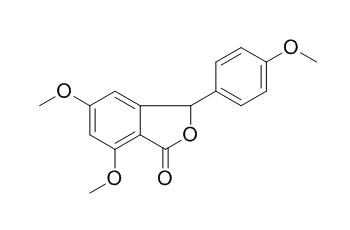5,6-Desmethylenedioxy-5-methoxyaglalactone
5,6-Desmethylenedioxy-5-methoxyaglalactone is cytotoxic to small cell lung cancer (NCI-H187) cell line. It has antimycobacterial activity against Mycobacterium tuberculosis H(37)Ra.
Inquire / Order:
manager@chemfaces.com
Technical Inquiries:
service@chemfaces.com
Tel:
+86-27-84237783
Fax:
+86-27-84254680
Address:
1 Building, No. 83, CheCheng Rd., Wuhan Economic and Technological Development Zone, Wuhan, Hubei 430056, PRC
Providing storage is as stated on the product vial and the vial is kept tightly sealed, the product can be stored for up to
24 months(2-8C).
Wherever possible, you should prepare and use solutions on the same day. However, if you need to make up stock solutions in advance, we recommend that you store the solution as aliquots in tightly sealed vials at -20C. Generally, these will be useable for up to two weeks. Before use, and prior to opening the vial we recommend that you allow your product to equilibrate to room temperature for at least 1 hour.
Need more advice on solubility, usage and handling? Please email to: service@chemfaces.com
The packaging of the product may have turned upside down during transportation, resulting in the natural compounds adhering to the neck or cap of the vial. take the vial out of its packaging and gently shake to let the compounds fall to the bottom of the vial. for liquid products, centrifuge at 200-500 RPM to gather the liquid at the bottom of the vial. try to avoid loss or contamination during handling.
Appl. Sci. 2021, 11(17),7829
Molecules.2022, 27(4):1412.
Biomed Pharmacother.2020, 131:110673.
Nat Prod Commun.2017, 12(5):771-778
Journal of Ginseng Research2021, 15 June.
Antioxidants (Basel).2023, 12(12):2078.
Korean Journal of Plant Resources2021, 34(1):52-58.
Int J Mol Sci.2024, 25(19):10660.
Pharmacognosy Magazine2017, 13(52):868-874
Front Pharmacol.2019, 10:1226
Related and Featured Products
Nat Prod Res. 2011 Oct;25(17):1621-8.
Biologically active constituents of Aglaia erythrosperma.[Pubmed:
22011221 ]
METHODS AND RESULTS:
From the fruits and leaves of Aglaia erythrosperma (Meliaceae), 10 chemical constituents were isolated and identified, i.e. the dammarane triterpenoids cabraleadiol (1), cabraleahydroxylactone (2), ethyl eichlerianoate (3), eichlerialactone (4), aglinin A (5), cabralealactone (6), the aglaialactone 5,6-Desmethylenedioxy-5-methoxyaglalactone (7), the flavagline 4'-demethoxy-3',4'-methylenedioxy-methyl rocaglate (8) and two coumarins: scoparone and scopoletin.
CONCLUSIONS:
Flavagline 8 exhibited antimalarial activity with an IC(50) value of 7.30 μg mL(-1) and was strongly cytotoxic against small cell lung cancer (NCI-H187), epidermoid carcinoma (KB) and breast cancer (BC) cell lines, with IC(50) values of 2.17, 2.10 and 0.11 μg mL(-1), respectively. Aglinin A (5) displayed moderate cytotoxicity against all the three cancer cell lines, whereas ethyl eichlerianoate (3), cabralealactone (6) and the aglaialactone 7 were exclusively cytotoxic to NCI-H187 cell line. Cabraleahydroxylactone (2) showed antiviral activity against herpes simplex virus type-1 with an IC(50) value of 3.20 μg mL(-1), in comparison with the standard acyclovir (IC(50) = 1.90 μg mL(-1)). When tested for antimycobacterial activity against Mycobacterium tuberculosis H(37)Ra, compounds 1-4 and 6-8 displayed minimum inhibitory concentration in the range of 25-50 μg mL(-1).
Bioorg Med Chem Lett. 2007 Jan 1;17(1):109-12.
Ponapensin, a cyclopenta[bc]benzopyran with potent NF-kappaB inhibitory activity from Aglaia ponapensis.[Pubmed:
17055270 ]
METHODS AND RESULTS:
Two new compounds, a cyclopenta[bc]benzopyran, ponapensin (1), and an aglaialactone, 5,6-Desmethylenedioxy-5-methoxyaglalactone (2), together with nine known compounds were isolated from the CHCl(3) soluble extract of the leaves and twigs of Aglaia ponapensis. Their structures were established by spectroscopic data interpretation. Ponapensin (1) exhibited significant NF-kappaB inhibitory activity in an Elisa assay, and was found to be more potent than the positive control rocaglamide.
CONCLUSIONS:
All of the compounds isolated were also tested in a panel of human cancer cell lines, with the known sterol E-volkendousin (3) and methyl rocaglate (aglafoline) found to be the only active substances.



